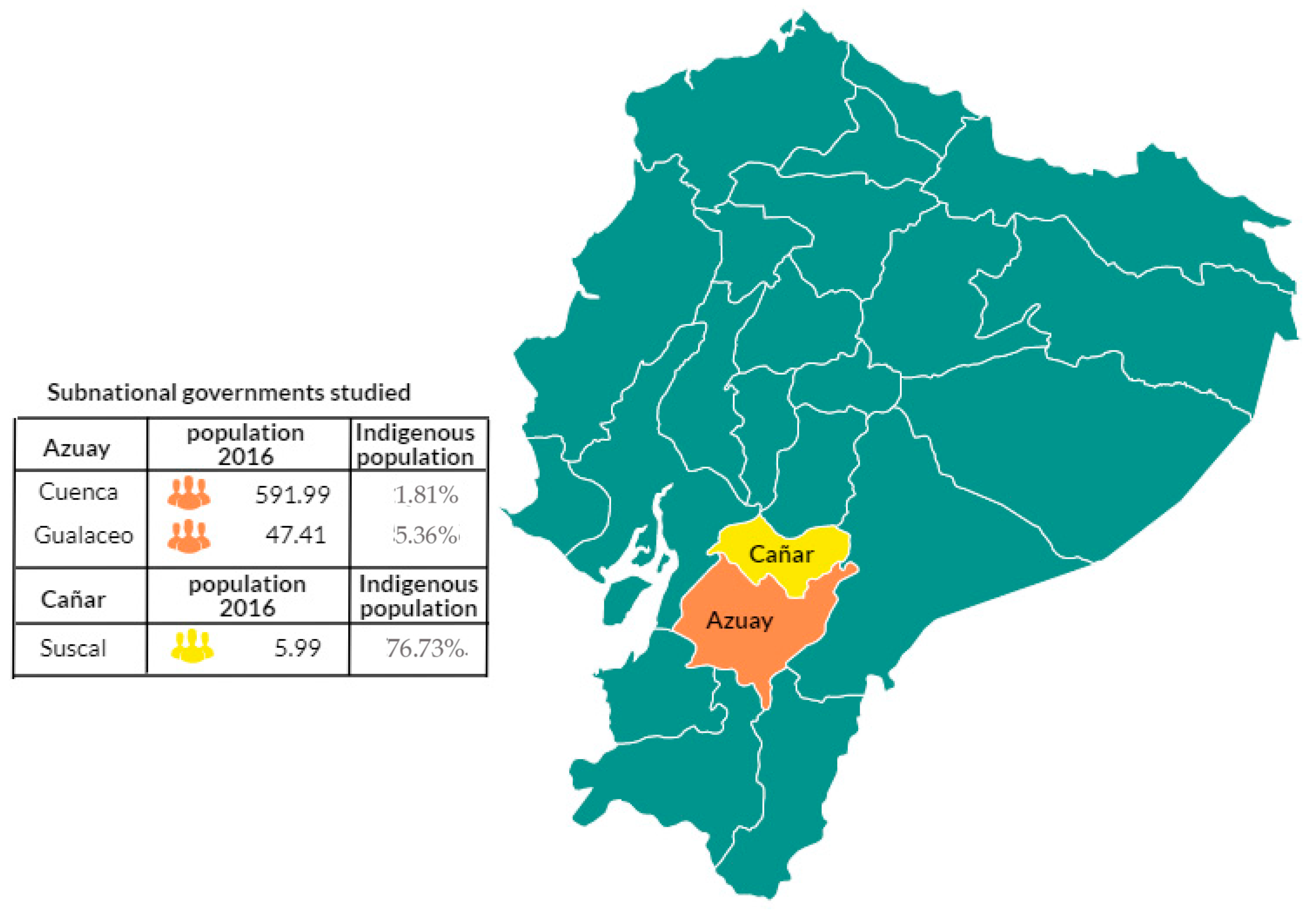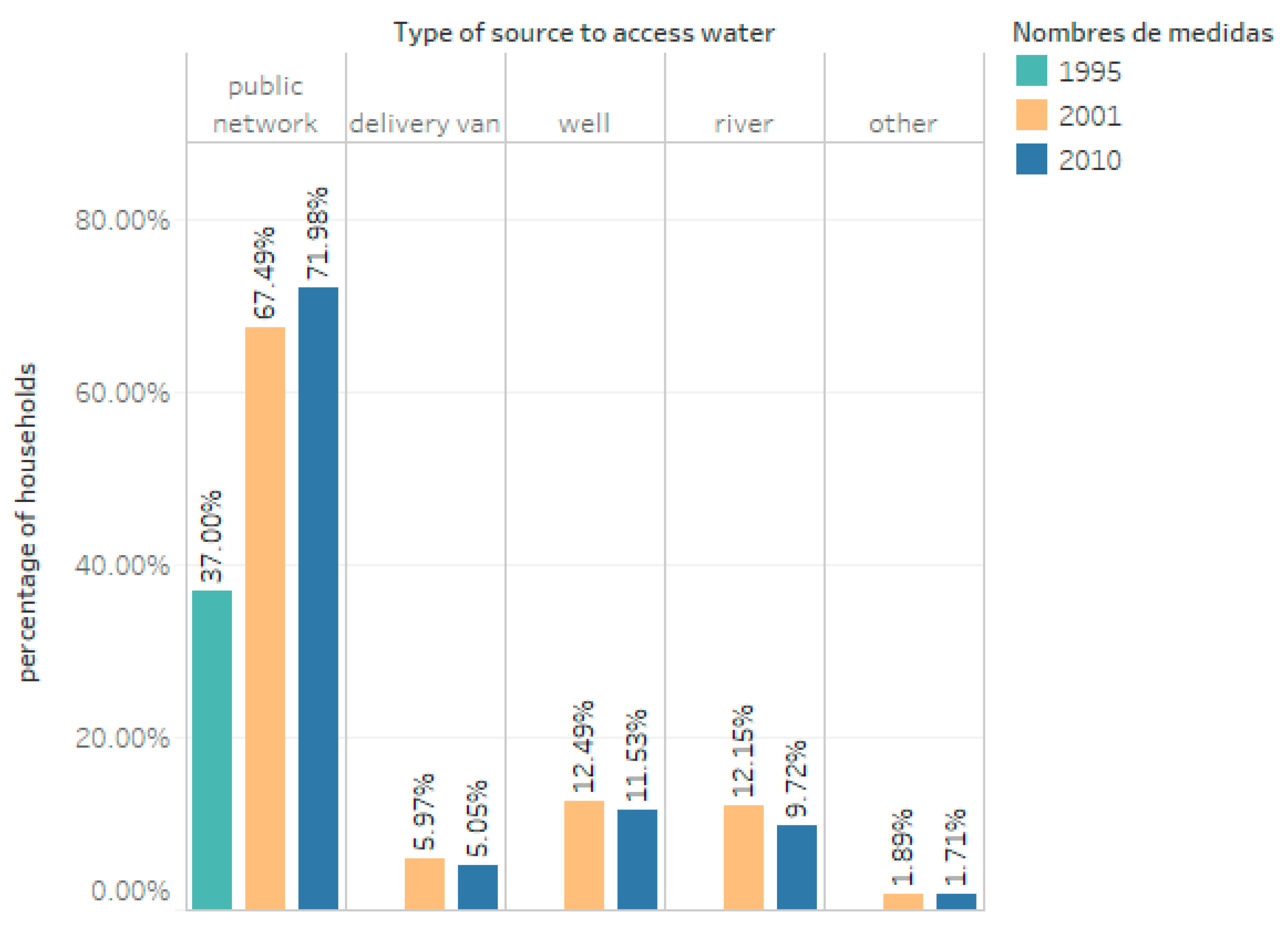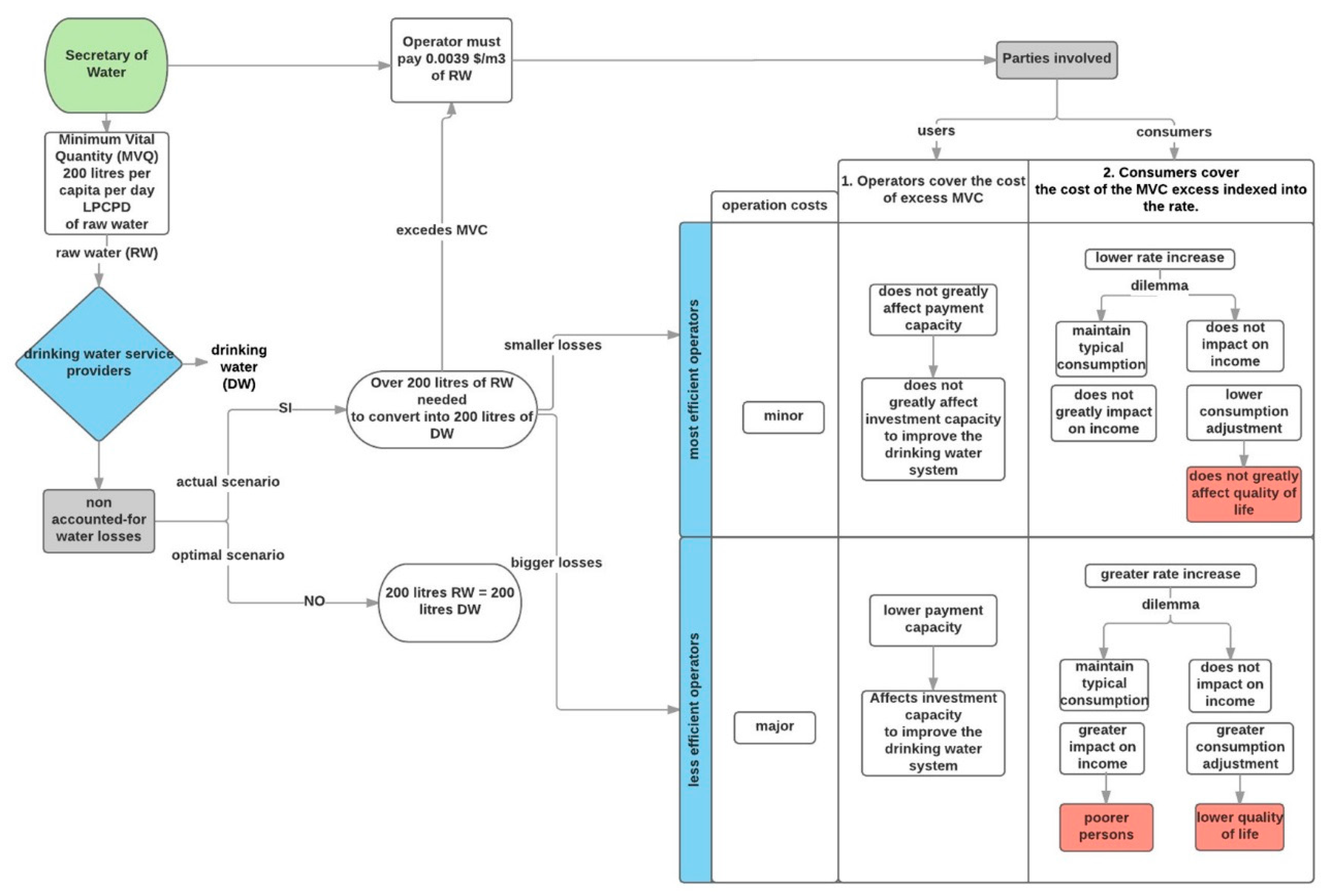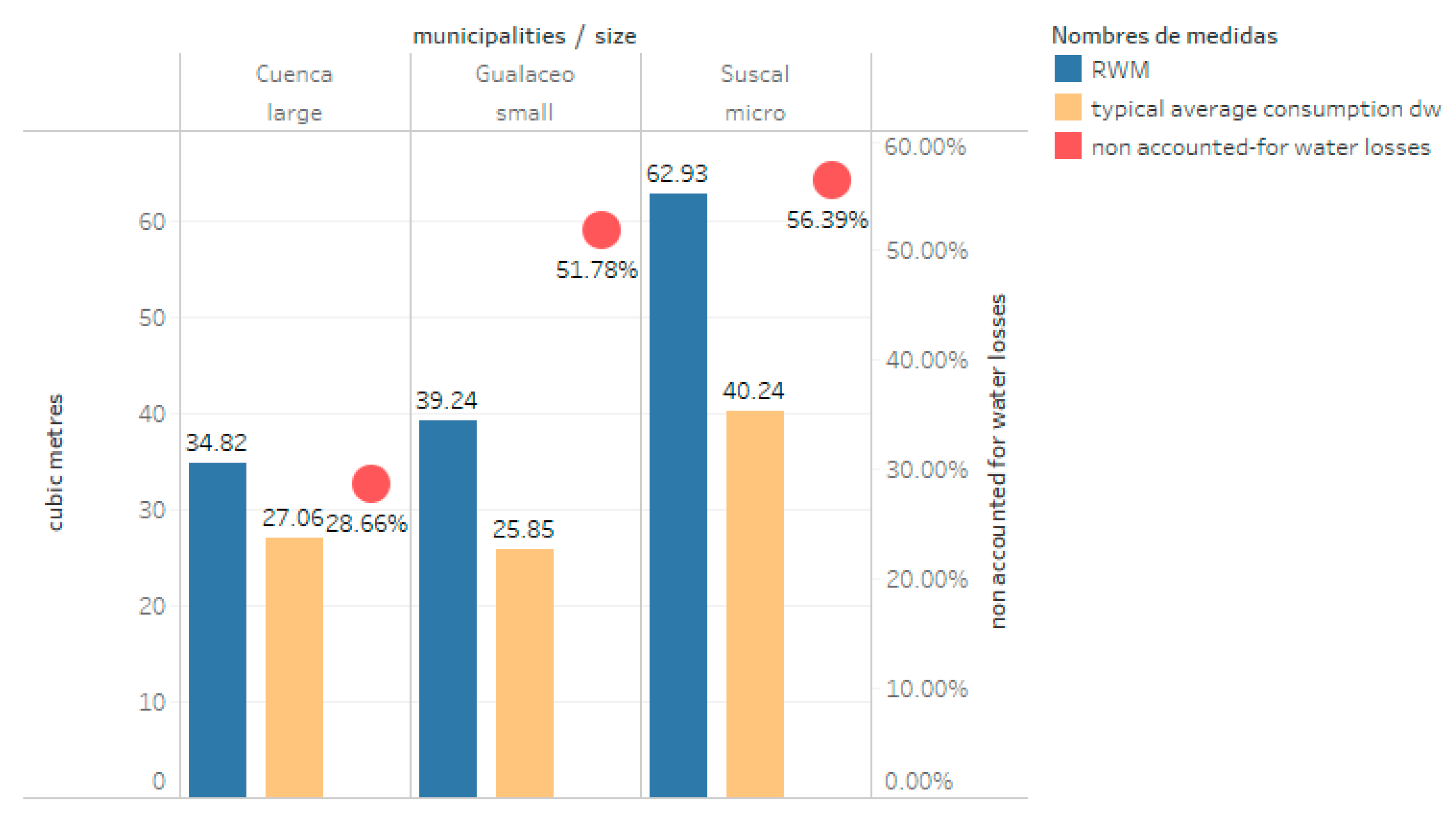1. Introduction
From a normative standpoint, the case of Ecuador presents a peculiarity in relation to water management. Until 1960, water administration remained private; the State simply intervened to resolve disputes and authorize usage. That year water was declared a national good, a principle ensured in 1972 when all continental waters of the country were declared public domain. In 1993, the process of State modernization affected the provision of public services, including water provision and management which was delegated to the National Council of Water Resources (1994) [
1]. In 2008 Ecuador’s new Constitution reconfirmed the State as primary authority for water management, conservation, recovery, integrated management of water resources, watersheds and ecological flows associated to the water cycle (Art. 411 and 412).
An important feature of the Ecuadorian case is that irrigation water regulations have been prioritized over drinking water regulations due to the influence of 1970s Agrarian Reform, which generated a policy of subsidies and debt write-offs in favor of indigenous and peasant groups. This has produced an important gap between water access, efficiency and quality in rural and urban areas. With the new constitutional framework and the creation of the National Water Authority (SENAGUA) in 2008, access to drinking water has been increased (from 69% in 2006 to 83.6% in 2016). In the rural areas, however, the access to water through public connection is only 59%.
In May of 2017, SENAGUA signed the Ministerial Agreements No. 2017-1522 and 2017-1523, which approved the formula to calculate the cost of raw water, as well as the minimum amount of drinking water (200 L) guaranteed under the 2008 Ecuadorian Constitution. As positive as the recognition of the right to water is, quantifying a vital minimum amount of water per person poses the following complex questions: first, is the standardization made in Ecuador correct, since it doubles the international average? Second, is the application of the vital minimum of water widening the differences between subnational governments regarding the provision of water, quality of service, financial capacity of the lending companies, and quality of life for families?
The purpose of this research is to determine the extent to which the application of these Ministerial agreements increases (or reduces) the differences between local governments, in terms water provision efficiency, and the economic capacity of the most vulnerable families to pay for water exceeding the Constitutionally-guaranteed vital minimum amount. The study selected three different municipalities in the austral area of Ecuador (See
Figure 1): Cuenca the third largest city in the country, with 591.996 inhabitants, recognized for its efficiency in the provision of public services [
2,
3], Gualaceo and intermediate city with 47.411 inhabitants [
3], and Suscal a small city of 5.998 inhabitants, with an indigenous majority (data based on [
3,
4]). The working hypothesis is that the application of the Minimum Amount of Raw Water (MARW) negatively affects the three subnational governments, both suppliers and most vulnerable consumers. We expect a greater effect in municipalities that are less efficient in the provision of potable water services and that have a socially and economically vulnerable population.
2. Background
According to the World Health Organization (WHO), access to the vital minimum amount of drinking water is directly related to hygiene and public health. Thus, ensuring a minimum access to water is crucial.
The WHO states that there should be a minimum acceptable quantity of water to cover basic needs, such as drink, food preparation and hygiene. In order to measure water requirements with provision of water services and its impact on healthcare, the WHO establishes four service levels (see
Table 1): service without access, basic access, intermediate access and optimal access [
5]. The first level, service without access (less than 5 L per day), cannot guarantee minimum hygiene conditions and entails a high risk for poor health. Basic access (20 L per day) guarantees basic hygiene (hand-washing), although the risk for poor health remains high. Intermediate access (50 L per day) assures basic personal and food hygiene and health. Finally, optimal access (100 L per day and more), satisfies all hygiene needs.
Access to water for domestic consumption is defined by WHO as: “water used for all usual domestic purposes including consumption, bathing and food preparation”, taking into account the following categories: drinking water (for drinking and cooking); water for personal hygiene (basic needs and personal care); and, water for domestic cleaning (car-washing, garden-watering, etc.) [
5]. However, authors such as Thompson [
6], suggest that a fourth category, “productive use”, should be included. This category should be applied to households with depressed economies in developing countries, in reference to the water that is used for small-scale agriculture and livestock, construction, etc. (Falkenmark argues that 1369 L/c/d (500 m
3/c/y) is the minimum required to run a modern society living in semi-arid conditions, with 1095 L/y) required for irrigation, and 274 L/c/d (100 m
3/c/y) for domestic and industrial needs).
The United Nations Children’s Fund (UNICEF) and World Health Organization (WHO), through their Joint Monitoring Program, define reasonable access to water as “the availability of at least 20 L per person per day from a source within one kilometer of the consumer’s home” [
6]. However, this definition refers to access, not to the quantity that is recommended in liters per capita per day (LPCPD). The discussion regarding the minimum amount of water needed by an individual includes other variables such as the type of activity that is performed, the temperature, the geographical conditions, etc. [
7].
Regarding the protection of rights related to water resources, the 108th plenary meeting of the General Assembly of United Nations (With 122 votes in favour, no votes against, and 41 abstentions), held in 28 July 2010, recognized drinking water and sanitation as human rights. In this sense, Ecuador was ahead of the region by innovatively recognizing water as a fundamental and inalienable human right in the 12th article of the 2008 Constitution. Water is also considered a strategic national heritage of public use, and above all, essential for life. Other countries that made the same recognition prior to 2010 are South Africa (1997) (“Other countries have recognised the right to a healthy environment in their constitutional texts. Whilst over 60 constitutions refer to environmental obligations, less than a half expressly refer to the right of the citizens to a healthy environment. Only the South African Bill of Rights enshrines an explicit right to access to sufficient water” [
8]), Uruguay (2004), and Bolivia (2009) [
9].
When applying human rights principles to water and sanitation, the following concepts should be observed: non-discrimination and equality; access to information and transparency; participation; accountability, and sustainability. It also should include: availability, physical accessibility, quality and safety, affordability, acceptability, dignity, and privacy [
10,
11].
The Ecuadorian Constitution defines water as: (a) a human right; (b) a national heritage and strategic sector; (c) a public service; and (d) an element to achieve food and energy sovereignty. As a human right, it is the State's primary duty to guarantee water (Art. 3, No. 1.) In fact, water is regarded as a fundamental and inalienable human right protected under the right to well-being (Art. 12). This implies that it cannot and should not be isolated but understood in interrelation with other rights, by virtue of its interdependent and indivisible character (article 11, No. 6), especially in connection to the right to health (article 32) and to a dignified life (Art. 66).
As a strategic national patrimony of public use, water is inalienable, inseparable, non-excludable, and essential for life (Art. 12). Decision and control is the exclusive responsibility of the State, which administers, regulates, controls, and manages water in accordance with the principles of environmental sustainability, precaution, prevention, and efficiency (Art. 313). The Constitution states that water is vital for nature and for the existence of human beings and, therefore, cannot be privatized (Art. 318).
As a resource to achieve energy sovereignty, constitutional provisions establish that this sovereignty shall not be reached in detriment of, or by compromising, water supplies. To this effect, the State will promote, in the public and private sectors, the use of environmentally clean technologies, and non-polluting and low-impact alternative energies (Art. 15). Similarly, water is a development goal in Ecuador. The Constitution states that one of the goals is to recover and conserve nature in order to maintain a healthy and sustainable environment, as means to provide people and communities an equitable, permanent, and high quality access to water, air, and soil (article 276, No. 4).
Water and its preservation are also the responsibility of the State in order to achieve food sovereignty. To ensure this, the State must promote redistributive policies, which give peasants access to land, water, and other productive resources (Article 281 No. 4), bearing in mind that it is the State’s obligation to avoid the monopolization or privatization of water and its sources. In addition, the State shall regulate the use and management of irrigation water for food production, under the principles of equity, efficiency, and environmental sustainability (Article 282).
Finally, the Ecuadorian Constitution considers water and its provision a public service (Art. 314.) In fact, water sanitation, supply, and irrigation can only be provided by national or communal entities. The State will encourage alliances between public and community sectors to provide water related services (Art. 318). By means of a constitutional clause, municipal governments of Ecuador are assigned the responsibility of providing potable water, sewage and wastewater treatment, and are forbidden to suspend any of these services (Art. 264 No. 4; Art. 326 No. 15.) It is the obligation of the State, at all the levels of government, to guarantee the uninterrupted provision of public drinking water services (Art. 375 No.6).
3. State of the Art
On the 28 July 2010, the United Nations General Assembly recognized the right to water, sanitation and hygiene (WASH). WASH was granted the status of an essential human right, since it guarantees both the enjoyment of life, as well as other human rights. In its resolution 64/292, the Assembly called upon the subjects of international law to provide resources, and technical and technological assistance, especially for developing countries, so that their populations can access drinking water and sanitation. Such access must be sustainable, since there is no point in having access to water through platforms and infrastructure if this is not sustainable over time, due to low quality or high maintenance costs [
10]. If this condition is not met individuals will become unprotected again and, consequently, will lack access to water.
The Inter-American Human Rights System, through the Inter-American Court, Inter-American Commission, and its case law, has developed two transcendental criteria in the field of drinking water. The first deals with quantity and quality of water for the development of a dignified life, in the case of the Xákmok Kásek Indigenous Community vs. Paraguay, of 24 August 2010. The second relates to the minimum living conditions for persons deprived of their liberty, in in the cases Vélez Loor vs. Panama, date 23 November 2010, and Pacheco Teruel et al. vs. Honduras, of 27 April 2012. This last criterion establishes that the State must provide drinking water to all inmates to guarantee a dignified life.
In general, the application of the human right to drinking water and sanitation is progressive. Each State must develop and expand its coverage so that all inhabitants can gradually have access to these services, avoiding a setback for human rights in this area. However, as pointed out [
10] in the Special Rapporteur’s report on these rights: the main risks, especially in times of crisis, are the budget cuts that affect the development of infrastructure and provision of public services. This directly impacts human rights, such as the right to health, since people with fewer resources (“The cuts in public spending particularly affect the poorest and most marginalized, whose income usually comes mainly from social benefits, which depend heavily on public services and devote a greater part of their income to basic services” [
10]) are unable to access quality water or have their service interrupted due to lack of payment. Given disproportionate increases in rates, the lack of income from unemployment during such times leaves vulnerable groups without the resources to pay for essential services.
In 2007, Ecuador presented the “II National Report on the Millennium Development Goals” (The report was prepared by the Millennium Social Research Center (CISMIL), composed of the United Nations Development Program (UNDP), the Latin American Faculty of Social Sciences, FLACSO in Ecuador, and the National Secretary for Planning and Development (SENPLADES)). In it, the National Secretary of Planning and Development acknowledged that while progress had been made in access to drinking water and sanitation, the territorial gaps (urban/rural, coast, highlands and Amazon Region) are still considerable.
Figure 2 shows the evolution of drinking water access in Ecuador since 1995 when only 37% of Ecuadorian households had access to water through the public network. This percentage grew to 67% in 2001 and to 71.98% 2010. Ecuador’s drinking water coverage has improved in the last decade, from 69% (2006) to 83.6% (2016), thanks to the significant investment in accessibility by the Local Governments, which have the capability to provide the service. According to the statistics from the Joint Monitoring Program (JMP) of WHO and UNICEF in 2015, coverage levels of drinking water services in Ecuador have increased to 92% at a national level, 97% in urban areas, and 82% in the rural areas.
3.1. Analysis of International and National Case Law on the Vital Minimum Amount of Drinking Water
Regarding international case law, there are two cases concerning the determination of a vital minimum of drinking water. The first, in South Africa, of Lindiwe Mazibuko and others against the city of Johannesburg, in 2009, in which two issues were discussed: (a) if the basic free water supply, that is, 6 kiloliters per month for each connection holder (or, 60 L per person per day), was in conflict with the Constitution; and, (b) if the installation of prepaid water meters was legal, as they worked with coins resembling parking meters, for the excess rate. The Constitutional Court considered that as there were too many answers to the question of what constitutes a sufficient amount of water, therefore, a specific vital minimum should not be determined, since that decision corresponded to the legislator or the government as a matter of public policy.
The second case corresponds to the Constitutional Court of Colombia, in its Judgment T-740, of 2011. The Sentence determined that the vital minimum of drinking water is 50 L per person per day. The constitutional judge developed the fundamental right to water applying the Resolution of the General Assembly of the United Nations as “soft law” for the legal system, obliging the Operator to reconnect, restore the service, and review payment agreements so that the user could afford them. It also mandated the installation of a flow redactor which guarantees the minimum water for consumption (50 L). Finally, it ordered the national government, through the local government, to subsidize 50% of the costs, for the user to pay for the service.
The Colombian decision is based on the following criterion: “... The deprivation of drinking water entails a serious violation of the state obligations derived from the fundamental right to water, specifically those of availability and accessibility, inasmuch as, first, it restricts the possibility that this sector of the population, which is in a circumstance of manifest weakness, has access to the services and facilities of water, and second, the availability of water for the satisfaction of personal and domestic needs, such as the preparation of food, personal hygiene and household hygiene. Thus, in the event of failure to pay more than two consecutive billing periods, the public water utility should, as has been pointed out in this Corporation’s case law, report the credit situation of the user, and the procedure to follow, so that she can keep up to date with her obligations ...” (Full sentence available in [
14]).
In the Ecuadorian case, the Constitutional Court ruled on the management and administration of strategic sectors, through decision No. 001-12-SIC-CC. This rule absolves the President’s consultation on the content of the articles 313, 315 and 316 of the Constitution. The consultant, after stating that during the 1990s there was a privatizing tendency from the State, manifests that the current Constitution seeks to guarantee the satisfaction of collective needs through the priority intervention of the State in the management of strategic sectors, as well as public services. Distinguishing between the administration, regulation, and control of those sectors, which corresponds to the Central State according to Art. 313 of the Constitution; and the management which corresponds to public companies, as established in Art. 315 of the same legal body [
15].
For this reason, two doubts arise regarding the application of the mentioned articles. The first is that public companies, being part of the State, either enjoy or lack administrative, regulatory, and control powers in strategic sectors and public services. The second refers if the rest of the state organizations (such as any Ministry), have to create a public company, if they want to manage a strategic sector.
Regarding the first consultation, the Constitutional Court mentions Art. 313 of the Constitution, which establishes the exclusive power of the State to manage, regulate, control and operate the strategic sectors. Although these powers have been granted to the State, it is possible to distinguish between the central State and public companies. The first is responsible for the administration, regulation, and control through the competent public administration authorities, in accordance with the law. In addition, the seconds, the public companies which are authorized only for the management of a strategic sector, and in every case it is obligatory to obtain the authorization from the central State (Regulatory and control organs) [
15].
Article 316 establishes a priority order for the management of strategic sectors and the provision of public services: State; joint ventures in which the state has a majority shareholding; private initiative and popular and solidarity economy. We have, therefore, the State’s own management, and delegation, which can appear in two cases. The first refers to the aforementioned joint ventures, and the second, to private entities [
15]. The latter is exceptional and only applies when it is necessary to satisfy the general interest, and the State does not have sufficient technical or economic capacity, or when demand cannot be met by public or mixed companies [
16].
Therefore, the Court concludes that the power attributed to the State in Art. 313 manifests itself through two concrete functions. The first is the authorization granted by the central State to public companies, to manage strategic sectors and provide public services. The second is in the delegation that the State can grant to non-public companies to perform such management [
15].
Regarding the second consultation, the Court states that when State institutions, as a means to provide public services inherent to their competence, need to manage strategic sectors, they will not need to establish public companies for that purpose. It will only be necessary to have access to the corresponding enabling titles granted by the regulatory and control authorities [
15]. Thus, the Ministries, not being public companies, can request such titles themselves.
3.2. The Vital Minimum Quantity of Drinking Water in the Ecuadorian Legislation
The Organic Law on Water Resources, Uses and Exploitation of Water, in defining the human right to water, refers to its availability. According to the Law water should be clean, sufficient, healthy, acceptable, accessible and affordable, for personal and domestic use. Then the vital or “vital minimum” amount of water is important since no person can be deprived, excluded or stripped of this right. It can be considered as the cornerstone on which the enforceability of the human right to water is based. In this way, raw water destined to be processed within this range is free.
Article 18 defines the competence and attribution of the Single Water Authority to set the rates to authorize the use of water. In this context, one day before the end of the last Presidential term (23 May 2017), the Secretary of Water signed Ministerial Agreements No. 2017-1522 and 2017-1523. These agreements established the calculation formula to obtain the raw water referential rate, fixing the minimum vital amount of water in 200 L per capita per day as a minimum amount unified value). Later, the new Administration (2017–2021) amended Ministerial Agreement No. 2017-1522 through Agreement No. 2017-0010, dated 28 June 2017. It established a new administration for SENAGUA—now presided by a former indigenous leader, linked to community water management, which specifically reformed the rates to authorize the use of water.
The raw water referential rate is based on the formula of total costs of water sustainability, over the authorized national volume of water, which has duration of 5 years. However, the most important thing is the differentiation made in the rate according to the type of use and/or utilization, where those who use less than 5 L per second for activities linked to food sovereignty are exempt from payment; while rates are significantly taxing for productive irrigation, industrial use, tourism, hydroelectricity and water bottling.
As for Agreement No. 2017-1523, it establishes the minimum vital amount of water in Ecuador at an equivalent of 200 L of raw water per inhabitant per day. Therefore, the excess consumed above the vital minimum should be charged for. The charging entities are the providers of drinking water services at a national level (Municipal Government or its Public Companies, and Drinking Water Boards).











